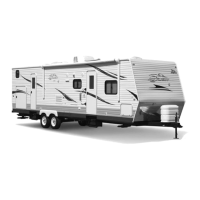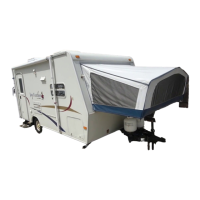L.P.-GAS
SYSTEM
WARNING:
L.P.-Gas containers shall not
be
placed
or stored inside the
vehicle. L.P.-Gas containers are equipped with safety devices which re-
lieve excess pressure by discharging gas into the atmosphere.
WARNNG:
IT
IS
NOT
SAFE
TO
USE
COOKING
APPLMCES
FOR
COMFORT
EEATING.
Cooking appliances need fresh air for safe opera-
tion. Before operation:
1.
Open overhead vent
or
turn on exhaust fan, and,
2.
Open window
This warning label has been located in the cooking area to remind you to
provide an adequate amount
of
fresh air for combustion. Unlike homes,
the amount of oxygen supply is limited due to the
size
of
the recreational
vehicle, and proper ventilation when using the cooking appliance(s) will
avoid danger of asphyxiation.
It
is especially important that cooking
appliances not be used for comfort heating,
as
the danger of asphyxiation
is
greater when the appliance
is
used for long periods of time.
A
warning label has been located near the L.P.-Gas container. This label
-
reads:
DO
NOT
FICE
CONTAtNEB(S)
TO
MORE
TEEAN
80
PERCENT
OF
CAPACITY
OverIXling the L.P.-Gas container can result in uncontrolled gas flow
which can cause fire or explosion.
A
properly filled container will contain
approximately
80
percent of its volume as liquid
L.P.-Gas.
WAXNIHG:
Portable fuel-burning equipment, including wood and char-
coal grills and stoves, shall not be used inside the recreational vehicle.
The use
of
this equipment inside the recreational vehicle may cause fires
or asphyxiation.
WARNING:
Do not bring or store L.P.-Gas containers, gasoline
or
other
flammable liquidshside the recreational vehicle. Disregarding this warn-
ing
may result in fires or explosions.
The following label has been placed
in
the vehicle near the raage area:
BF
YOU
SMElCZ
GAS:
I.
Extinguish any open flames, pilot lights, and all smoking materials.
2.
Do not touch electrical switches.
3.
Shut off the gas supply at the tank valve(s) or gas supply connection.
4.
Open doors and other ventilating openings.
5.
Leave area until odor clears.
6.
Have the gas system checked and leakage source corrected before
using again.
Note:
L.P.-Gas regulators must always be installed with the diaphragm
vent facing downward. Regulators that are not in compartments have
been equipped with
a
protective cover. Make sure that regulator vent
faces downward and that cover is kept in place to minimize vent blockage
which could result
in
excessive gas pressure
causing
fire or explosion.

